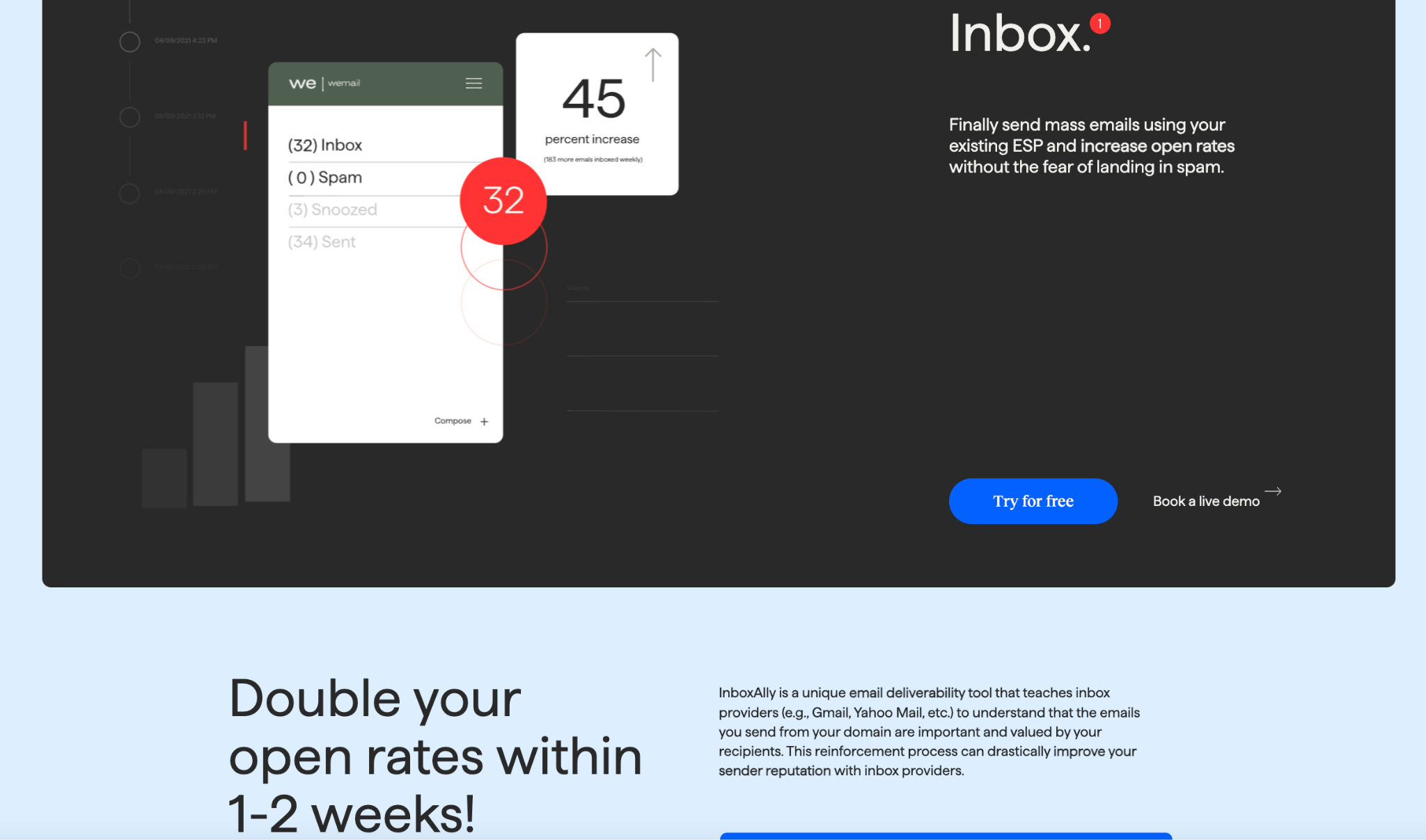Cold email marketing can be costly. However, there’s no denying that it is a powerful type of marketing. We created this Cold Email – The Ultimate Guide For 2023/2024 for you.
Some people say it’s not working for them, and it’s most likely because they’re doing it wrong. Don’t worry if it happens to your campaigns, too. In this ultimate guide, we’ll cover the strategies to set up your cold email marketing for success before even hitting send.
But first, let’s properly understand what cold email is.
What is a Cold Email?
A cold email is an initial email sent to a prospect – someone you don’t know but hope to build a business relationship with.
Thus, it’s referred to as “cold” because you have no prior contact with the recipient. This form of marketing strategy can be challenging. However, when done right, it can level up your sales outcomes.
Let’s now look at the difference between cold and warm emails to avoid confusion:

Cold Email vs. Warm Email: What’s the Difference?
If cold emails are unsolicited emails sent to strangers, warm emails, on the other hand, are target outreach emails sent to previously known contacts.
You can also send it to people you met at webinars or prospects who have previously engaged with your company, product, or services in some way.
Related: Cold Email Checklist
When to Use Cold Emails
Lead Generation
You can use cold email to generate leads. It’s where you email a potential customer and introduce your product or service, talk to them about its benefits, and how it can be helpful to them.
In addition, you’ll gain a warm lead once the recipient knows they need what you offer them. With that, you can continue with the sales conversation.
Brand Awareness
Another use case of cold emails is to build or increase brand awareness. It allows you to increase your prospects’ interest level by staying on top of their mind.
Of course, we don’t mean sending each customer four emails daily. That could backfire on your efforts. It could also simply be a form of campaign that promotes your activeness in the community and builds customer trust.
Form Partnerships
An excellent cold email campaign helps you create relationships. Whether you’re looking for affiliate partners or a referral, sending out cold emails is an effective strategy to form partnerships.
You can even use cold email marketing to send proposals and convince your potential partner that your collaboration will be mutually beneficial.
Link-building Opportunity
Cold email marketing is a link-building strategy that sends emails, sending a tailored message to industry influencers, bloggers, and website owners.
For this use case, the main purpose is to seek a link or other collaboration to aid in the development of backlinks and improve rankings in the search engine.
Recruitment
You may also recruit potential employees through cold emailing. It’s where you reach out to individuals who may be a good fit for a position in your company.
For instance, you are a hiring manager, and you’re looking for engineers. As an HR, you may have already created a list of qualified candidates, but they are not looking for a new job yet.
Therefore, if you want to communicate with them, you can draft a personalized cold email and inform them about the position. Moreover, you may highlight in your email how their skills and experience match the role.
A well-crafted cold email will not just grab your prospect’s attention but may even motivate them to apply.

Evaluate Market Viability
Marketers can use cold email to better understand the prospect’s pain point or check a product or service viability. In addition, they can use cold emails to collect market research data and conduct surveys.
Publicity
Another use case of cold email marketing is for publicity for your initiative, product, or service.
If your company has exciting data, an inspiring journey, or anything newsworthy to share, sending a cold email to the media to check if they’re interested in covering your story will help elevate your brand image.
As a result, it can bring in more visitors to your social media profiles and your website.
Pros and Cons of Cold Email Marketing
7 Benefits of Cold Emailing
1. Targeted
Cold emailing allows marketers to target specific businesses or individuals they believe can benefit their product or service. This benefit will even be more effective when you personalize the message to every recipient, boosting the chance of getting a response.
2. Cost-Effectiveness
Unlike traditional sales and marketing methods, cold emails are more cost-effective. You don’t have to spend as much on referrals and advertisements because you only need a well-crafted message and an email address.
3. Data Collection
Another advantage of cold email marketing is that it provides valuable information on the effectiveness of your campaigns, including click-through, open, and conversion rates.
4. Scalability
Cold email marketing is a scalable method of reaching potential clients or customers. You can send prospects hundreds or thousands of emails at once, getting as many people as quickly as possible. Check out our guide on How to Use MailChimp to Send Mass Email .
5. Quicker Responses
Compared to other marketing methods like online advertising or mailing, cold email outreach prompts your target audience to respond to you quickly. This increases your chance of marketing your product or service to them.
6. Measurable Results
With cold email marketing, you can track and measure the results of your campaign. Many email marketing services and tools you can use nowadays allow you to see who opened your emails or took the desired actions and clicked on links.
These data also allow you to adjust your email marketing strategy to boost campaign effectiveness.
7. Better ROI
Cold email offers a better return on investment (ROI) compared to other outreach methods when done correctly. It’s also easier to track open, reply, and conversion rates to determine the effectiveness of your marketing method and make the necessary adjustments.

4 Drawbacks of Cold Emailing
1. Legal issues
The legality of cold emailing can be a complex issue because it depends on the regulations and specific laws in each country or region. In the US, for instance, marketers must follow the CAN-SPAM Act when sending commercial emails.
Meanwhile, marketers in the European Union follow the General Data Protection Regulation (GDPR), where they have to obtain consent from individuals before they start sending marketing emails.
2. Spam filters
Some emails, even with a clear call-to-action and value proposition, get caught in the spam filter instead of landing in the inbox. While spam filters block dangerous emails by reviewing every message sent to an email address, they can also work against legitimate emails with suspicious properties.
3. Low response rates
Recipients usually ignore or delete cold emails. Most likely, the reason is that you’re sending emails while the recipient is busy at work or when they’re asleep. These can lead to a low response rate.
4. Time-consuming
Crafting and sending cold emails can be time-consuming. Thus, some businesses outsource the task to email marketing services at an additional cost.
Related: Cold Email Open Rates
How Much Do Cold Email Campaigns Cost?
A cold email campaign’s average monthly cost is approximately $350 per month to 50 targets. Of course, considering the fixed and variable costs, the price lowers if you send emails to more recipients.
Fixed costs stay the same even if you send to one or a hundred thousand recipients. On the other hand, variable prices may fluctuate depending on the number of cold emails you plan to send.
What Impacts Email Marketing Prices?
The cost of email marketing increases if you hire a cold email agency service or use a cold email marketing tool for a more comprehensive campaign.
Factors such as the scope of the project, the target market, the company’s size, the features and ease of use of the tool, and your business objectives can either increase or lower the overall cost of an email campaign.
So, why does it matter to know the email campaign cost?
Well, if you run your numbers and find a good ROI in utilizing cold email, it confirms that you’ve made a good business decision.
Some cold email marketing expenses you have to consider or include the following:
- Software cost
Different email marketing software and deliverability tools have other features and pricing plans. Some popular options include InboxAlly, Mailchimp, Campaign Monitor, and Yesware.
- Content creation cost
The cost of creating compelling and engaging email content depends on the type of content you make. For instance, HTML-based or interactive email can be more costly than text-based.
- List management and subscriber acquisition costs
Keeping your email up-to-date and clean is essential to the success of your email marketing campaign. The cost of list management is also linked to the service you use it for and the size of your list.
- Optimization and A/B testing software cost
The cold email marketing software you use may already have an email split testing feature. But if it doesn’t, you may have to shell out extra dollars every time you do optimization and A/B testing.
Related: No Response from Cold Email – How to Fix it

10 Best Cold Email Practices for 2023/2024
Writing a cold email that generates business leads requires respectful engagement and value-driven communication with prospects. Here are some of the best cold email marketing practices for 2023 and 2024 used by experts:
1. Understand Your Prospect
To be successful in cold email marketing, you need to learn who you’re writing and sending to. So, ensure you research your prospects. Learn not just who they are but what they do. Have a good grasp of their needs and how your business could also help them.
2. Write a Compelling Subject Line
You need a catchy subject line for your cold email outreach to get read. It means a descriptive subject line, yet concise. It should also prompt the recipient to open the email.
So, make your subject lines not sales-y and add a touch of personalization. And this brings us to our next email marketing strategy.
3. Personalize Your Emails
Personalization is the secret ingredient to running a successful cold email campaign. It also shows your prospects that you know who you’re communicating with.
Therefore, spend time studying each potential client instead of using cliched opening statements. Check their LinkedIn profile or website and learn more about their current projects, successes, possible pain points, and objectives.
Personalized cold emails give your brand or company more authority. They will also be more likely to be read or replied to.
4. Segment Based on Engagement
Segmenting your recipients into groups based on their engagement level will be a game-changer. Aside from their levels of engagement, you can also group them based on their interests and problems.
In addition, doing so will make it easy for you to craft content specifically designated for every group and address their requirements and unique problems more effectively.
As a business, the relevance and value of your offers will skyrocket when you address your client’s most pressing concerns. It will also positively impact your campaign, including higher conversion rates, greater trust, client loyalty, and positive word-of-mouth.
5. Keep Things Simple
Short and simple yet actionable cold emails usually get the best result. Most people don’t have much time to read complex emails.
So, establish a clear-cut, single purpose for sending the cold email to a target audience. Doing so will give your campaign the power to increase open and click-through rates.
There are also cold email templates you can use online as a baseline; ensure to edit them for your audience and their specific needs.
6. Proofread the Emails
Crafting a cold email with spelling and grammatical errors can derail your efforts and time for such a campaign. Even one mistake can signal a wrong impression to your prospects.
As such, you should prioritize proofreading your campaign before clicking the “send” button. Even if you’re using a cold email template, check and maintain a professional image to boost your chance of success.
7. End With a Strong Call-to-Action (CTA)
Include the CTA when you’re planning an effective cold email strategy.
Presenting a clear path to your recipient makes a strong CTA. It also makes it easy for the recipient to follow what you ask them.
8. Email at the Right Time
You can increase your chances of getting high open and response rates for your campaign if you send emails at the right time. Studies show that the best time to send a cold email is between 8 a.m. and 11 a.m., following the recipient’s time zone.
The reason for this marketing strategy is simple: most business professionals check their email first in the morning.
9. Add Follow-ups
Following up on our cold email outreach is essential in cold email marketing. Remember that the chance of getting a response to your first email could be higher, or recipients may completely ignore your email. It could be that they are busy or trapped by spam filters.
Therefore, follow-ups are always wise because you get to convey your message once more and educate them about how your service or product can solve their pain points.
10. Test and Optimize
Testing and optimizing your cold email campaign is necessary to know what’s working. You can experiment using A/B testing by sending emails with different email content, subject lines, and CTAs until you find the ideal combination that works well for your target market.
Choosing the Right Cold Email Tool
Crafting and automating your campaign is easier with the right cold email tool or software. Email deliverability tools, like InboxAlly, offer robust analytics. Hence, you know exactly the impact of your campaign and assess its performance.
The right cold email software will also optimize and streamline your email outreach efforts, making it a valuable tool for your sales team.
Here are some key factors to consider in choosing the right cold email tool or service:
Deliverability Rates
Email deliverability rate is the success rate in getting the email delivered to the target recipient’s email address. This factor is a crucial consideration when choosing the right cold email tool.
To ensure your campaign reaches your target audience, look for a tool or service provider with high deliverability rates.
Features
Choose a tool or service that provides features such as email automation, A/B testing, list management, repair or increase deliverability on any IP or domain, and allows you to set your own sending schedule.
Reputation
Does the email service have positive customer reviews and a good reputation? If so, that is a good sign.
Compliance
Look for an email-sending service compliant with email marketing regulations and laws to prevent your cold emails from landing in spam folders.
Analytics and Reporting
Lastly, your service provider should offer detailed analytics and reporting features so you can make data-driven decisions on your campaign and your overall business.
Wrap Up
Now that you’ve learned the best practices for cold email marketing for 2023 and 2024, what’s next?
Well, it’s time to craft a conversion-driven cold email campaign or make the necessary adjustments to your existing campaign.
And if your cold email outreach doesn’t take flight in the time you thought it would, don’t throw in the towel yet. Gain real insight first. Perhaps all you need is consistency and a little time to start seeing good results.
Good luck and happy prospecting!
If you want to ensure your cold email campaign produces positive results, try us for free for 10 days.
InboxAlly is a unique email deliverability tool used by deliverability experts, mailing list owners, email service providers, and agencies.
